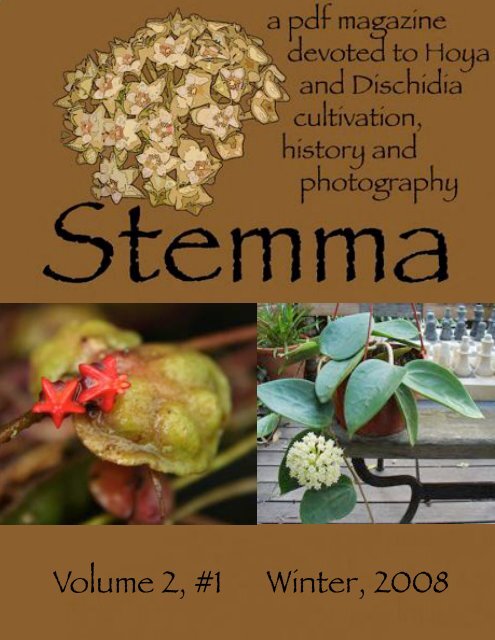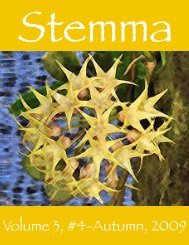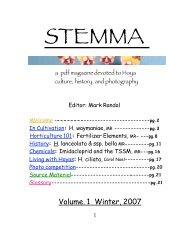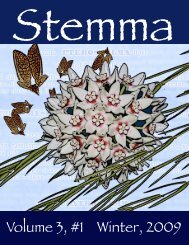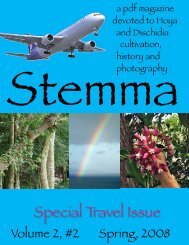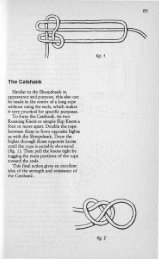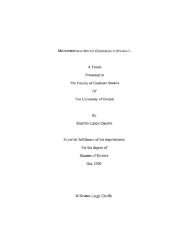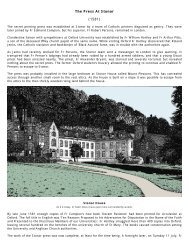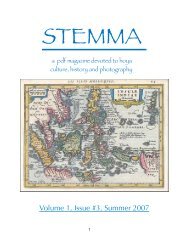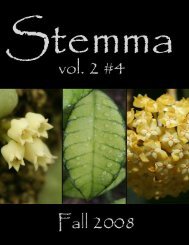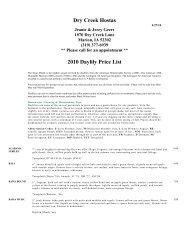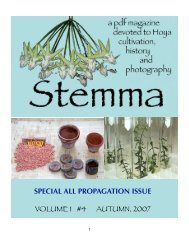You also want an ePaper? Increase the reach of your titles
YUMPU automatically turns print PDFs into web optimized ePapers that Google loves.
Volume 2, #1 Winter, 2008<br />
1
contents<br />
Editor's Note --------------------------------------------------------------------------3<br />
A Look at Dischidia by Antone Jones------------------------------------------4<br />
Photography, photos and text by Ed Gilding----------------------------------18<br />
Reprint: Hoya <strong>Pottsii</strong> from Curtis’ Botanical Magazine------------------21<br />
Hoya <strong>Pottsii</strong> Traill by Mark Randal------------------------------------------------24<br />
Department of Corrections, MR--------------------------------------------33<br />
Source Materials-------------------------------------------------------------------33<br />
Glossary--------------------------------------------------------------------------------34<br />
Appendix A: Lectotype of Hoya subquintuplinervis Miq. (Teysmann #6037) ------35<br />
Appendix B: Illustration of Hoya griffithii Hook f. from the Botanical Magazine-----36<br />
Back Page: Hoya griffithii Hook. f. by Torill Nyhuus-----------------------37<br />
Editor: Mark Randal<br />
Editor of Dischidia Content: Antone Jones<br />
Technical Consultant: Bobby Fisher<br />
Stemma Godmother: Carol Noel<br />
Usage Policy: Stemma may be distributed freely as a whole, but content and photos remain<br />
the intellectual property of the individual contributor and may not be reproduced<br />
separately. Use of any portion of Stemma (including photographic content) for commercial<br />
gain is strictly prohibited.<br />
2
Editor's Note<br />
Bonjour!<br />
Stemma is pleased to note that we are no longer the only organization in the Hoya world<br />
publishing digitally. Joining in this past summer (2007) is Asclep-Hoya, the revue of the<br />
AFAHO, the Association Francophone Des Amateurs De Hoya. The revue is published<br />
quarterly, and is one of the benefits of membership in this French language society.<br />
Another perk is the online French Hoya forum Monforums, on the web at:<br />
http://hoyas.monforum.fr/index.php<br />
Photographs taken by AFAHO members are<br />
viewable online at the innovative website Flickr, a<br />
photo sharing resource:<br />
www.flickr.com/groups/hoyasmonforumfr<br />
Another Flickr pool with AFAHO content, open<br />
to the larger Hoya growing community:<br />
www.flickr.com/groups/hoyas/pool<br />
Membership information for the AFAHO may be<br />
obtained by contacting Alexandre Gavrus at:<br />
email: kl55555@club-internet.fr<br />
Please place “AFAHO” in the subject header. n<br />
Left:<br />
Photographs of Hoya praetorii Miq. from the Asclep-Hoya<br />
revue no. 1<br />
_________________________<br />
3
A Look at Dischidia<br />
Text and all photos by Antone Jones<br />
(Antone is on-line at www.dischidia.com)<br />
Flowers of Dischidia sp. Geri<br />
Some of you are probably thinking to yourself, "Well... the title seems to be missing<br />
the word, Hoya." You'd be correct. In this article we are going to take an in<br />
depth look at the genus, Dischidia. We will uncover some of the mysteries that surround<br />
this sister genus of plants. So, go check on your plants and when you return,<br />
sit back, relax and enjoy the ride.<br />
4
General Info<br />
Dischidia was first described by R.<br />
Brown in 1810. The type species for<br />
the genus is the ever common and<br />
widespread Dischidia nummularia R.<br />
Br. (pictured at right) which is also<br />
known as the Button Orchid Plant.<br />
The genus Dischidia currently comprises<br />
approximately 80 species all<br />
of which are epiphytic. They are<br />
found throughout SE Asia stretching<br />
from India (D. bengalensis) all the<br />
way to Australia (D. nummularia).<br />
Dischidia can be found in the wild<br />
growing along side Hoya, often times occupying the same tree or even the same<br />
branch. Many species are myrmecodial (growing with ants) and have developed<br />
special foliage to accommodate their six legged friends. They can be found at sea<br />
level all the way up to over 2000m above sea level (Dischidia astephana).<br />
Presently there are three recognized sections of the genus: Ascidiophora, Conchophyllum<br />
and Dischidia. Sect. Ascidiophora contains the pitcher leaved species<br />
i.e., Dischidia major, D. vidalii, and D. complex (D. vidalii pictured). These pitcher<br />
leaves are utilized by arboreal ants for various things from a place to store larva to a<br />
waste facility. The pitcher leaves obtain nutrient from the ants by a single root that<br />
grows and spreads throughout the<br />
inside of the pitcher leaf. This is a<br />
great example of a symbiotic relationship;<br />
the ants get shelter and the<br />
plant receives nourishment. It has<br />
also been suggested that the pitcher<br />
leaves of D. major can also serve as<br />
a water reservoir if they are growing<br />
upside down. This would allow water<br />
retention when rain falls and collects<br />
inside the leaf.<br />
5
Top Left: D. diphylla, Top Right: D. cleistantha, Bottom: D. imbricata<br />
Sect. Conchophyllum contains the shell leaved species which includes, Dischidia<br />
diphylla, D. cleisthantha, D. imbricata and many more. These plants have developed<br />
flat foliage that grows extremely close to the surface they are growing on.<br />
What’s interesting about this group is that not only do they provide nesting sites for<br />
arboreal ants like sect. Ascidiophora but the flat, sessile growth habit also creates<br />
the perfect environment for root development. Underneath each pair of leaves is<br />
dark, warm and moist. This also enables these species to withstand significant<br />
amounts of drought.<br />
6
Sect. Dischidia contains all the other species which have laminate or “normal”<br />
foliage. This also includes the genus Dischidiopsis which is a genus of questionable<br />
validity; more on that later. Even though the species of this section don't have special<br />
foliar apparatuses, many of them are still myrmecodial. Species like Dischidia<br />
rimicola can be found growing directly out of the arboreal ant nests of the genus<br />
Crematogaster. It has been observed that the ants harvest the seeds of these plants.<br />
This explains the association perfectly. The ants bring the seeds to their nest; the<br />
seeds germinate and then grow from it.<br />
Left: Dischidia litoralis Right: Dischidiopsis luzonica<br />
The genus Dischidiopsis contains a handful of species with Hoya-like foliage. The<br />
heaviest concentration occurs in the Philippine archipelago but are also found<br />
sparsely throughout SE Asia. One of the key features of the genus is that none of the<br />
flowers possess the anchor shaped coronal appendages that Dischidia do. Oddly,<br />
not all species have them either. The species of this genus have the same habitat,<br />
growth and general floral characteristics as Dischidia which is why its validity is in<br />
the air. I believe in the future, these plants will all be moved to Dischidia.<br />
Some Dischidia have medicinal uses as well. The foliage of the shell leaved species,<br />
Dischidia purpurea are crushed and cooked in coconut oil. This is then used<br />
as pomade for eczema and herpes.<br />
7
Flowers and Foliage<br />
Dischidia astephana<br />
The flowers of Dischidia may not be as; "flashy" as those of Hoya but that does not make<br />
them any less interesting. Many species have spectacularly colorful flowers while others<br />
have powerfully fragrant ones. Some have fairly large flowers like those of Dischidia diphylla<br />
(which also smell heavenly) while others are so minute one would almost require a<br />
hand lens to view them.<br />
Dischidia flowers (like all Asclepiads) are 5-merous, meaning that they have five petals<br />
(flowers of D. diphylla pictured). They exist in a variety of shapes from the urceolate flowers<br />
of Dischidia singularis to the campanulate flowers of Dischidia rhombifolia. Some may<br />
bloom for many days up to a week or so while others seemingly last only a single day or<br />
just slightly more. Many are born on long peduncles where they<br />
can be seen by pollinating insects like those of Dischidia purpurea.<br />
Some may bloom in groups or singly as in Dischidia hirsuta.<br />
Anthesis* isn't always apparent in many Dischidia. This is<br />
because there are many species that have flowers that appear<br />
closed. Those of Dischidia vidalii seem to appear closed constantly.<br />
Conversely, Dischidia griffithii has flowers that are widely<br />
divergent at anthesis, allowing full view of the gynostegium*.<br />
8
These flowers posses a few unique floral characters that set them apart from Hoya<br />
and the other genera of the family. Many of them contain hairs on the inside of the<br />
corolla. Some of them are quite visible by the naked eye as they cover the entrance<br />
to the corolla. Other species contain hairs further down the corolla tube only to be<br />
seen via dissection. Another neat feature of Dischidia flowers are the anchor shaped<br />
coronal appendages found in many species. These appendages are attached to the<br />
gynostegium. They can provide a means for identification as they are very differently<br />
sized and/or shaped between those species which have them.<br />
Undescribed species from Thailand<br />
Left: Dischidia lancifolia Right: Dischidia merrillii<br />
9
Pollination of the flowers is an area of grey in this genus. Not much research has<br />
been conducted on the specific vectors for pollinating them. In Rintz's account of<br />
the Malayan Dischidia (1980) he mentions<br />
that the likely pollinators of Dischidia<br />
would be lepidopterans (moths<br />
and butterflies). He continues to say that<br />
many believe ants would be vectors for<br />
pollination because so many Dischidia<br />
are associated with them, but any ant<br />
that would be small enough to fit inside<br />
the flower would be far too small to dislodge<br />
the pollinium* and then insert it<br />
just right into the grooves formed by the<br />
anther margins. I have personally witnessed<br />
moths, butterflies, ants, wasps,<br />
bees and flies all feeding on the nectar of Dischidia flowers. This doesn't necessarily<br />
mean that they are all vectors for pollination but at least gives some insight into<br />
where to start. Pictured here is a wasp drinking nectar from Dischidia bengalensis.<br />
The foliage of Dischidia exists in a wide range of shapes, sizes and vesture from<br />
the very large leaves of Dischidia acutifolia to the hairy foliage and stems of Dischidia<br />
hirsuta (hence the name). Some species are nearly impossible to distinguish<br />
from a Hoya when sterile because of their size, shape and thickness. Dischidia superba<br />
comes to mind. Its foliage is large, heavy, hard and dark green. Dischidia<br />
lancifolia, D. astephana<br />
and D. singularis are<br />
particularly notable for<br />
their foliage and represent<br />
but a small sample<br />
of the variability and<br />
beauty found in this<br />
genus of plants.<br />
10<br />
Dischidia acutifolia
Top Left: Dischidia hirsuta Top Right: Dischidia lancifolia Center: Dischidia singularis Bottom: Dischidia astephana<br />
11
Identification<br />
Clone of Dischidia acutifolia. Compare with picture on page 10<br />
Identification of Dischidia can be an arduous and stressful task. Like Hoya, there<br />
are many clones of the same species in existence some of which have different looking<br />
foliage but identical flowers. Furthermore, new species and/or varieties are discovered<br />
every year which can add to the mayhem as well as the fact that so many are<br />
incorrectly identified or not identified at all due to the lack of info available.<br />
Some important things to remember are that, like humans, there is variability in a<br />
single species. Some species contain clones with large glabrous foliage while other<br />
clones may be tiny and covered in dense hairs. Cultural influence can greatly change<br />
the look of foliage as well. Low light, lots of food and high humidity often will create<br />
large, dark green leaves while lots of light, little food and moisture will yield smaller,<br />
harder foliage. Temperature, light and nutrients can influence flower color and because<br />
of this it’s sometimes important to ignore flower color and instead pay attention<br />
to flower morphology. The age of the plant can also confuse as some species' vesture<br />
changes with age. For example, often times some species start out with dense hairs<br />
on young foliage and then slowly drop the hairs as those leaves gain age. Dischidia<br />
hirsuta and D. astephana are two examples of this occurrence.<br />
The best thing to do is to always label and keep records of your plants. Knowing the<br />
origins of what you have can be a powerful weapon in the battle for identification.<br />
12
Cultivation<br />
Epiphyte walls festooned in Dischidia<br />
As was mentioned earlier, Dischidia can be found in nature growing on the same<br />
tree as many Hoya species. This would lead to the idea that their cultural requirements<br />
are similar. If you've got a green thumb for Hoya, then you should have no<br />
problems growing most Dischidia. If your thumb is not so green, there are still some<br />
excellent species to grow and enjoy.<br />
Dischidia are found most commonly growing epiphytically in the rainforest edges<br />
along streams, roads, on exposed limestone hills and beaches. This tells us that Dischidia<br />
appreciate moisture, air flow and light. So when we grow them at home, we<br />
must attempt to provide those 3 basic things which is easy to do.<br />
Dischidia can be grown potted or mounted and do quite well either way. Growing<br />
these plants potted or in hanging baskets is the easiest and most common<br />
method as mounts can be difficult to maintain for those who live in arid regions.<br />
Potting mixes should drain very well but retain some moisture. A regular feeding<br />
schedule in the active growth months with any good orchid fertilizer will greatly<br />
benefit these plants.<br />
In this section of the article I will detail some cultivation tips and general info for<br />
a few easy, moderate and difficult to grow species. There is a Dischidia for everyone<br />
from the expert to the novice. It should be noted that my comments here are based<br />
on experiences growing these plants outside and in a greenhouse in central Florida.<br />
13
Easy Species<br />
Dischidia sp. Geri (hort) is an endemic to the Philippines.<br />
It has to be one of the most recognizable and/or common<br />
species available. This is no surprise as it is practically impossible<br />
to kill. The leaves are round and coin-like. The<br />
flowers are lantern shaped and white. The petals are held<br />
erect at anthesis. This species appreciates moisture and can<br />
handle being over watered better than any of them in my<br />
experience. It grows very well in indirect sun, damp not<br />
wet and well fed.<br />
Dischidiopsis luzonica Schltr. is one of the best beginner<br />
species to grow. This is because not only is it<br />
hardy and indestructible but it also blooms very<br />
early in age and seems to stay in bloom constantly.<br />
This species does the best potted in a well draining<br />
mix, fed sparingly and kept damp not wet. It loves<br />
to be root bound and will fill a pot with roots in no<br />
time flat. D. luzonica is endemic to the Philippines<br />
and it grows FAST!<br />
14<br />
Dischidia ruscifolia Decne. Ex Becc.<br />
(commonly called the, “Million<br />
Hearts Vine”) also hails from the<br />
Philippines. It is a shrubby species<br />
and doesn't twine so it is pretty<br />
much strictly a repelling grower.<br />
This species doesn't like too much<br />
root moisture and can handle quite<br />
a bit of sun. There is a tiny clone<br />
available that is also very fun to<br />
grow and has the same cultural requirements.
Moderate Species<br />
Dischidia truncata Decne. comes from the highlands of Java. It’s a smaller climbing/<br />
twining species. The leaves have a beautiful broad lanceolate* shape. The flowers<br />
are born on approximately one inch peduncles<br />
in small groups of four or five and<br />
are long, tubular, white and have pink/<br />
purple tips. Being that D. truncata is a<br />
highland species, it poses some cultural<br />
problems for those in warm climates but it<br />
is probably one of the more tolerant highland<br />
species. It does best for me kept<br />
shaded and damp but with decent air<br />
flow. It does equally well mounted or potted.<br />
Dischidia nummularia R. Br. is very common<br />
and widespread in SE Asia and can be found<br />
nearly everywhere. The flowers are most often<br />
born singly on sessile peduncles, are<br />
white and have a ring of hairs that conceals<br />
the entrance to the corolla. There are many<br />
clones of this species and all are slightly<br />
challenging to grow for those of us who are<br />
trigger happy with the water. This species<br />
does best left to dry out completely before being soaked again. D. nummularia is<br />
highly tolerant of high light levels and seems to be more prone to blooming when<br />
grown “high and dry”.<br />
Dischidia merrillii Schltr. is a beautiful trailing species<br />
from the Philippines. The leaves are lanceolate,<br />
smooth, thin and oddly hard. The flowers are<br />
a livid purple and tubular in shape. Its closest<br />
relatives are D. lancifolia and D. hirsuta. D. merrillii<br />
can be a little challenging because it really<br />
needs very high humidity and this can be difficult<br />
for those in the drier areas. It also appreciates<br />
some root moisture, bright indirect sun and food.<br />
It will reward with multiple flower filled peduncles<br />
if these needs are met.<br />
15
Difficult Species<br />
Dischidia scortechinii King & Gamble is a<br />
highland species from peninsular Malaysia.<br />
The foliage is lanceolate, has palmate venation<br />
and is rather thin and fragile. The flowers<br />
are white, tubular, have reflexed lobes<br />
and are born on short peduncles in groups<br />
of 4 or 5. This species is very sensitive to<br />
light and heat. D. scortechinii prefers bright<br />
shade, lots of humidity and temps no higher<br />
than 80 degrees F (27 degrees C). If you live<br />
somewhere very warm, its best to keep this plant constantly misted and in a shady<br />
area with decent airflow but take care not to over water the soil mix.<br />
Dischidia astephana Scort. ex King & Gamble is a<br />
shell leaved species found in the mountain<br />
forests of peninsular Malaysia and Borneo.<br />
The foliage is notable for the small bumps<br />
and dense hairs. The flowers are red and blue<br />
and shaped like an onion. D. astephana (like<br />
many shell leaved species) seems to do best<br />
mounted but can be grown potted. It likes<br />
high light, moisture and cool temps. The foliage<br />
will blush a beautiful red in intense light.<br />
Be careful with feeding as too much will create flimsy weak foliage that seems to<br />
have more problems with rot.<br />
Dischidia dolichantha Schltr. is a wiry vine, highland<br />
species from peninsular Malaysia, Sumatra and Borneo.<br />
Its foliage is very similar to D. scortechinii but<br />
much smaller and slightly narrower. The flowers are<br />
very long, tubular and white with reflexed lobes. D.<br />
dolichantha is also culturally similar to D. scortechinii<br />
but seems to be slightly more forgiving with<br />
temps. This species seems to do much better potted<br />
vs. mounted because the thin stems rot when surrounded<br />
by damp moss.<br />
16
I hope you have found this article enjoyable and most importantly informational.<br />
These plants are beautiful and fun to grow and as such, deserve the attention of<br />
anyone who enjoys growing Hoya or any plant. The various species can be fun to<br />
display and always attract attention when visitors arrive. So hop on the internet or<br />
go to your local garden center and try a species or two. You won’t regret it! Happy<br />
growing!<br />
-Antone<br />
n<br />
17
Photography<br />
Photos and text by Ed Gilding<br />
(Editor’s note- This continuing feature in Stemma will focus on non-traditional photography<br />
and subjects as well as the beautiful floral photography created by many Hoya<br />
growers and collectors. The microphotographs featured in this issue were captured by Ed<br />
Gilding using a scanning electron microscope. These are 60x to 200x magnification images<br />
of the inner corollas of flowers of Hoya carnosa R. Br.)<br />
18
The tall banana-like appendages appear (we would need to stain<br />
fixed tissue with a dye that lights up the nuclei to confirm this) to be<br />
single cells called trichomes, which are modified epidermal cells.<br />
19
What is interesting is that it seems the trichomes form in small elongated<br />
bunches and appear to be very smooth (waxy exudates?*) so<br />
that they form scales, as seen with the naked eye. n<br />
_________________________________________________<br />
20
Reprint: Hoya <strong>Pottsii</strong> Traill from Curtis’ Botanical Magazine, 1835<br />
21<br />
(Editor’s note- This is the first<br />
in a series of reprints of important<br />
publications of Hoya<br />
or Dischidia species from past<br />
botanical magazines and<br />
journals. This material is often<br />
available only in certain botanical<br />
libraries or herbariums,<br />
often in locations inaccessible<br />
to many researchers<br />
or hobbyists. The digitalization<br />
of these entries and their<br />
correspondingly wider accessibility<br />
is an important and<br />
exciting advance and is being<br />
enacted by many sources- the<br />
two most notable being the<br />
Google Book Search project<br />
(www.books.google.com) and<br />
the Missouri Botanical Garden<br />
(www.botanicus.org).<br />
Google is working to digitalize<br />
and make searchable and<br />
viewable in their entirety an<br />
extraordinary number of noncopyrighted<br />
older texts, as<br />
well as excerpts of copyrighted<br />
works, and The Missouri<br />
Botanical Garden provides<br />
free and complete access<br />
to over 250 rare texts<br />
from the 18th and 19th centuries.)
( 3425 )<br />
<strong>HOYA</strong> POTTSII. MR. POTTS’S <strong>HOYA</strong><br />
********************<br />
Class and Order.<br />
PENTANDRIA DIGYNIA.<br />
( Nat. Ord. ---ASCLEPIADEAE. )<br />
Generic Character.<br />
Massae pollinus laeves, 10, erecto-conniventes. Antherae membrana terminatae. Corona<br />
staminea pentaphylla, foliolus depressis, angulo interiore producto in dentem<br />
antherae incumbenetem. Cor. rotata. Br.<br />
Specific Character and synonyms.<br />
<strong>HOYA</strong>* <strong>Pottsii</strong>; follis cordato-ovatis brevi-acuminatis supra trinerviis, corolla supra<br />
vix pubescente.<br />
<strong>HOYA</strong> <strong>Pottsii</strong>. Traill, in Hort Trans. v. 7. p. 25. t. 1.?, Loddiges, Bot. Cab. t. 1609*.<br />
Cultivated in the stove of the Bot. Garden of Glasgow, where it flowers in May. it<br />
is much to be regretted that MR. TRAILL, in his otherwise valuable paper on the<br />
different species of <strong>HOYA</strong>, has not more precisely defined the characters between<br />
his <strong>HOYA</strong> <strong>Pottsii</strong> and H. trinervis. Our plant is undoubtedly the H. <strong>Pottsii</strong> of the<br />
Bot. Cabinet, but the colour of the flowers is different from that of Mr. TRAILL,<br />
and in this respect, as well as in some others, it agrees better with the trinervis, of<br />
which its author says, “It bears a great resemblance to H. <strong>Pottsii</strong>, from which, however,<br />
it may be principally distinguished by its larger and thinner leaves, the veins<br />
of which are more strongly marked, and also by the yellowish colour in the centre<br />
of the crown.” May not the two varieties be one and the same plant? in ours, the<br />
22
old leaves at the base of the plant are much thicker than the upper ones, and have<br />
the nerves more obsolete. From H. carnosa the species is best known by its larger,<br />
broader, three-nerved leaves, and the almost entire absence of down upon the upper<br />
surface of the corolla. It wholly wants the bright red spots in the inside of the<br />
crown and the rich smell certainly cannot be compared to that of a “rich plumcake,<br />
or a combination of that of honey with the almond flavour of the Peruvian<br />
heliotrope,” (to which that of H. carnosa is likened by Sir J. E. SMITH,) but rather<br />
resembles that of strong and bad honey.<br />
If we are correct in considering the plant to be the original H. <strong>Pottsii</strong>, it is a native<br />
of the vicinity of Macao, where a leaf was gathered by a zealous collector to the<br />
Horticultural Society, whose name it bears, and which, being given to Mr. SABINE,<br />
and planted, soon flourished. The H. trinervis was brought from China by Mr.<br />
JOHN DAMPER PARKS.<br />
DESCR. Stem long, branched, twining, the extremities frequently leafless and<br />
rooting. Leaves ovato-cordate with a short acumen; when old, very thick, and between<br />
fleshy and coriaceous, convex below, and pale-green, with scarcely an appearance<br />
of nerves; above concave, deep-green, with one central and two lateral<br />
nerves, the middle one sometimes sending out very obscure lateral oblique ones,<br />
the margin slightly revolute. Petioles rounded, short, very thick; when old, clothed<br />
with a sort of pale-brown bark. Peduncle from the side of one of the petioles at its<br />
base, two inches long, bearing a compact almost globose umbel of flowers. Calyx<br />
with five short, broadly ovate teeth. Corolla rotate, of five broadly ovate, acute,<br />
very pale yellow-green lobes, quite glabrous below, above so slightly downy that<br />
the pubescence can only be seen by the assistance of a microscope. Crown of five<br />
large, depressed, fleshy, ovate, spreading, white leaves, between which the color is<br />
orange.<br />
* Named in honour of Mr. THOMAS HOY, gardener to His Grace the Duke of<br />
Northumberland.<br />
* The last citation should read “Loddiges, Bot. Cab. t. 1969”.<br />
___________________________________________<br />
23
Hoya <strong>Pottsii</strong> Traill<br />
by Mark Randal<br />
Lectotype illustration of Hoya pottsii from Transactions of the<br />
Horticultural Society, James Traill, 1830.<br />
24<br />
The species Hoya pottsii trail<br />
has a complex publication<br />
history and an uncertain relationship<br />
to the collections<br />
now in cultivation believed to<br />
represent this species. The<br />
type illustration for this plant<br />
(left), which appeared in<br />
18301, depicts a plant with<br />
trinerved* leaves with acuminate*<br />
tips. The flowers here<br />
have pale, reflexed corollas*<br />
and concave-topped white coronas*<br />
with raised apexes and<br />
red markings on the inner corona.<br />
The stems appear rather<br />
thick as do the leaves, judging<br />
by the depicted leaf edges.<br />
The original type description<br />
for this species cites the collection<br />
locale as Macao, a district<br />
in extreme south-eastern<br />
coastal China, and the collector<br />
as John Potts, for whom it<br />
was named.<br />
Since its original description,<br />
subsequent publications<br />
have placed Hoya pottsii into<br />
synonymy under other species<br />
names2, or conversely<br />
have placed other species<br />
into synonymy under Hoya<br />
pottsii3. The distribution has<br />
been defined variously as localized<br />
to southern China4 or<br />
occurring primarily in Australia<br />
and New Guinea3.
In cultivation many Hoya with diverse floral and leaf morphology have received the<br />
label “Hoya pottsii”, some appearing to be very similar to the type illustration with its<br />
trinerved leaves and some being very different, having pinnate*, triplinerved* or quintuplinerved*<br />
leaves and differing floral characteristics.<br />
Some botanists question whether any of the plants in cultivation match the type sheet<br />
of this species well enough to be labeled Hoya pottsii5.<br />
Key publications of Hoya pottsii Traill<br />
Hoya pottsii was first described in Transactions<br />
of the Horticultural Society 7<br />
(1830) by James Traill. The material described<br />
here was cited as having been collected<br />
in the vicinity of Macao (SE China),<br />
although this claim has been questioned in<br />
later works3. Hoya pottsii was featured in a<br />
number of works through the 1830s and<br />
‘40s, but little was added to the description<br />
in these publications, the text in these instances<br />
often being excerpted from the<br />
original publication. Two exceptions are<br />
the illustration that appeared in The Botanical<br />
Cabinet6 in 1833 and the illustration<br />
and description appearing in Curtis’<br />
Botanical Magazine in 18357 (this article is<br />
reproduced in its entirety in the Reprint section<br />
of this issue of Stemma). Around this<br />
time several articles appeared which supported<br />
the collection of this species from<br />
southern China4,8.<br />
This species received a major revision in<br />
the 1992 article “Taxonomic Studies on the<br />
Genus Hoya R. Brown in Papuasia” by Forster<br />
& Liddle3 which appeared in the Australian<br />
botanical journal Austrobaileya. Here the<br />
authors defined the distribution for this<br />
species as “Celebes, New Guinea and Australia”,<br />
and placed the species Hoya<br />
nicholsoniae F. Muell., Hoya hellwigiana Warb.<br />
and Hoya sogorensis S. Moore into synonymy<br />
with Hoya pottsii. They also designated the<br />
plate which accompanied the original publication<br />
of Hoya pottsii in Transactions of<br />
the Horticultural Society 7 as the lectotype*<br />
for this species.<br />
25<br />
Illustration of H. pottsii from The Botanical Cabinet, 1833.<br />
This image is Photoshop reconstructed from a very poor<br />
photograph, the only image available to Stemma,<br />
so is not an exact reproduction.
In Blumea 40 (1995)2 a treatment of Hoya verticillata G. Don places Hoya pottsii and approximately<br />
a dozen other names as synonyms* to Hoya verticillata. This work is based<br />
on the premise that Sperlingia verticillata (Sperlingia was a genus description written for<br />
the genus Hoya at about the same time, but beaten to publication by the genus description<br />
“Hoya”), one of two species described for that genus, was synonymous with a broad<br />
combined taxon* of species which included H. pottsii and H. acuta Haw. (a species collected<br />
originally from eastern India with flowers similar to H. pottsii, but leaves bearing<br />
pinnate* venation- see image page 32). The placing of H. pottsii as a synonym to Hoya<br />
verticillata does not seem to have been accepted by most botanists5,9,10, and does not often<br />
appear in this form in subsequent literature.<br />
In 1995-96 The Hoyan12 printed a series of articles attempting a tentative revision of the<br />
sectional divisions (where groups of species are put together based on similar physical<br />
characteristics) of the genus Hoya. There Christine M. Burton created a new sectional division,<br />
section Hoya subsection lactisuccus C. M. Burton, which had Hoya pottsii as its representative<br />
species.<br />
The description for this subsection reads, in part, “foliage fleshy; sap milky; corolla<br />
lobes flat or reflexed; corona lobes more or less flat on top but often elevated at the outer<br />
tips”. Other species placed in this section at the time were Hoya aldrichii Hemsl., hoya<br />
bhutanica Grierson & D. G. Long, Hoya hellwigiana, Hoya nicholsoniae (these first four listed as<br />
synonyms for pottsii), Hoya benquetensis Schltr., Hoya bordenii Schltr., Hoya incrassata<br />
Warb., Hoya finlaysonii Wight, Hoya glabra Schltr., Hoya merillii Schltr. and several others.<br />
Given that this study was published over 10 years ago, and was not intended to be an exhaustive<br />
placing of species known at the time, there are a great many more species that<br />
now would likely be placed here as well, such as Hoya acuta, Hoya macrophylla Blume,<br />
Hoya pachyclada Kerr, Hoya wibergiae D. Kloppenburg and many others. Even considering<br />
only the originally placed species, this subsection contains species which cover very<br />
nearly the entire range of the genus distribution for Hoya (see map page 27) and probably<br />
constitutes the largest group of morphologically similar Hoya species.<br />
While this study was a preliminary attempt to revise the sections and despite sectional<br />
theory having fallen somewhat into disfavor following Burton’s work and a revision by<br />
Dale Kloppenburg13 a few years previous to the Burton study, this new grouping remains<br />
significant as it is the first time that these species, so similar in floral character, were officially<br />
recognized as a distinct taxon inside the genus Hoya.<br />
In Thailand, most botanists currently seem to view Hoya pottsii and Hoya acuta as parts<br />
of a single variable taxon which they deem the “Hoya parasitica (Roxb) Wall. ex Traill complex”11.<br />
While the view of these two species as part of a wide, variable taxon (as in the<br />
Blumea article) may certainly be argued, the name Hoya parasitica is not a valid name for<br />
this complex or for any single species. A version of the name Hoya parasitica first appeared<br />
in 1814 as Asclepias parasitica in a catalog of plants of the East India Company’s<br />
Botanical Garden at Calcutta14. This name appeared there only as a catalog entry, with no<br />
description. The name Hoya parasitica did not appear until 182415, after the 1821 publication<br />
of the name Hoya acuta, which name Hoya parasitica was placed under synonymy<br />
to in 189816.<br />
26
A map detailing the collection sites of some of the Hoya in subsection lactisuccus. The red border defines the<br />
distribution of the genus Hoya, based on historical and modern collections and citations. Collections of H. pottsii<br />
are in blue, H. nicholsoniae are in green, and the pink numbers are similar species thought to be closely related<br />
to both. (1)- Chiang Mai, Thailand, source of the pottsii collection depicted on pages 29 and 30. (2)- Macao,<br />
China, cited as the original collection vicinity of H. pottsii. (3)- H. nicholsoniae. (4)- H. pottsii IML1449.<br />
(5)- H. pottsii IML1193. (6)- H. pottsii IML1395 (7)- H. acuta. (8)- H. bhutanica. (9)- Hoya rigida . (10)- H.<br />
cominsii. (11)- H. hellwigiana. (12)- H. samoensis. (13)- H. neocalidonica. (14)- H. neoebudica. (15)- H. merillii.<br />
(16). H. finlaysonii.<br />
Identity of Hoya pottsii in distribution and cultivation<br />
In determining which populations in nature or collections in cultivation best match the<br />
type material and description of Hoya pottsii, it is necessary first to take a moment to discuss<br />
the determination of the plant present in cultivation as Hoya sp. from Chiang Mai.<br />
This thick leaved, semi-succulent plant has been determined, by various authorities, to<br />
represent either the species Hoya subquintuplinervis Miq. or the species Hoya pottsii. In<br />
considering this determination it is necessary to consider one more plant, a truly succulent,<br />
round leaved plant which has also been sold as Hoya pachyclada GNT (Green Nontypical<br />
Form) and Hoya IML 1701. The botanists who consider Hoya sp. from Chiang Mai<br />
to be a collection of Hoya pottsii consider this plant (H. pachyclada GNT, IML1701) to be<br />
the true Hoya subquintuplinervis.<br />
27
Here is a photo montage of (from left) a typical leaf from Hoya IML1701, a detail from<br />
herbarium sheet Teysmann #6037 labeled as a lectotype* for Hoya subquintuplinervis,<br />
and a typical leaf from Hoya sp. from Chiang Mai.<br />
When comparing these images please note that the lectotype detail shows a rounded<br />
leaf with several prominent veins branching off from the midvein ABOVE the leaf base.<br />
This form of branching is called triplinerved (with three main veins) or quintuplinerved<br />
(with five main veins). This compares very favorably with the leaf shape and venation of<br />
the leaf from IML 1701. The stem of the lectotype material is also extremely thick, which<br />
compares favorably with IML 1701 (see the entire lectotype sheet in Appendix A).<br />
The representative leaf from Hoya sp. from Chiang Mai is, by contrast, ovate (eggshaped)<br />
with a more pronounced acuminate* tip and is prominently trinerved (three main<br />
veins, all arising from the same point at the leaf base). The resemblance of the leaves,<br />
stems and peduncles of the lectotype material to that of IML 1701 are blatant and would<br />
seem to preclude the determination of Hoya sp. from Chiang Mai as Hoya subquintuplinervis.<br />
So what is Hoya sp. from Chiang Mai?<br />
28
A comparison using a photograph of (left) a wellgrown<br />
flowering specimen of Hoya sp. from Chiang<br />
Mai (pottsii) and (right) the lectotype illustration<br />
for Hoya pottsii. Photograph by Roy Bilbie of<br />
Brisbane, QLD, Australia.<br />
Let’s compare Hoya sp. from Chiang Mai with the lectotype of Hoya pottsii. Note that<br />
the leaves of each are ovate with an acute* tip. In each there are three prominent veins<br />
that arise at the same point at the leaf base. The flowers of each are pale, with reflexed<br />
corollas and coronas which are broad in the middle, acute at either end and have a<br />
slightly concave flat top with the corona lobe apexes slightly higher than the center.<br />
There are also some slight differences. The leaf bases of Hoya sp. from Chiang Mai are<br />
slightly rounded, while those of the pottsii lectotype are more acute. The underside of the<br />
leaves depicted in the pottsii lectotype are of a lighter color than the tops, while those of<br />
Hoya sp. from Chiang Mai are uniform in color on both surfaces, except where exposed<br />
to direct sun. The inner tip of each corona lobe of the pottsii lectotype is colored a deep<br />
red, giving each corona a distinct red central spot while those of Hoya sp. from Chiang<br />
Mai have a yellowish coloration in the central corona.<br />
29
Comparison of flower clusters of (left) closeup of H. pottsii lectotype and<br />
(right) photo of H. sp. from Chiang Mai (pottsii) by Roy Bilbie of Brisbane, QLD, Australia.<br />
The leaf base shape of the type illustration is depicted as slightly acute, but the written<br />
description cites the leaf base as being “cordate”, which matches well to Hoya sp. from<br />
Chiang Mai. While the type illustration has priority over the written description, both the<br />
written description and this painting were made from the same single clone of this species<br />
in cultivation at the time (see reprint), so this factor would not seem to be concrete,<br />
and can be (as are the color of the underside of the leaves and the coloration of the inner<br />
corona) considered variable minor traits within a species17. Stronger floral and leaf variation<br />
than this may be seen in the differing colors of flowers in various clones of Hoya<br />
archboldiana C. Norman and Hoya imperialis Lindl. and in the varying leaf size and shape<br />
within the species Hoya australis R. Br. ex J. Traill.<br />
So the Hoya sp. from Chiang Mai seems to be properly determined as Hoya pottsii from<br />
Chiang Mai.<br />
Chiang Mai is a region of northern Thailand approximately 1500km (just over 900<br />
miles) southwest of the Macao region of southern China which is cited as the original collection<br />
area for Hoya pottsii.<br />
There are several other collections of Hoya pottsii from this general region (Thailand,<br />
Malaysia and Vietnam) which match well with the pottsii type: H. pottsii IML 1395, from<br />
the Cameron Highlands, Malaysia and H. pottsii IML 1449 from southern Thailand both<br />
display the colorful leaves and red centered corona which is illustrated in the lectotype.<br />
H. pottsii IML1193 from Vietnam, with green tinted corollas and magenta centered coronas,<br />
also represents this species, although no collections from China itself seem to be<br />
identified in cultivation so far.<br />
30
Above left: Hoya pottsii IML1395 from Malaysia.<br />
(photo of IML1395 courtesy of David Liddle.)<br />
Above right: Hoya pottsii IML1193 from Vietnam.<br />
Now let’s look at the Hoya native to Australia<br />
and New Guinea that have been<br />
placed into synonymy with pottsii.<br />
These collections were determined to be<br />
Hoya nicholsoniae18 before they were<br />
placed in synonymy under Hoya pottsii by<br />
Forster and Liddle3. To the right is a montage<br />
of David Liddle’s illustration of H.<br />
nicholsoniae showing triplinerved* or<br />
quintuplinerved* leaves and two collections<br />
of nicholsoniae with matching venation.<br />
This vein pattern does not match well<br />
to the type illustration of H. pottsii.<br />
The floral characteristics of the Hoya<br />
nicholsoniae collections to date are rather<br />
varied. Some have highly rhombic* corona<br />
segments with a distinctively flat-looking<br />
top, and a rather compact arrangement<br />
compared to the coronas of pottsii from<br />
Thailand and Vietnam.<br />
31<br />
i
Other collections have corona<br />
segments which are<br />
extremely similar in shape<br />
and placement to those of<br />
the northern pottsii species<br />
(as well as to those of Hoya<br />
acuta- see photo comparison<br />
to the left). One collection,<br />
IML0039, has corona<br />
segments with rounded<br />
apexes. All of these collections<br />
have triplinerved<br />
veins, however, which distinguishes<br />
this group from<br />
the northern population of<br />
Hoya pottsii.<br />
Are H. pottsii and H.<br />
nicholsoniae similar enough<br />
plants to be defined as the<br />
same species? A case may<br />
be made either way, and it<br />
seems that genetic testing<br />
may be a way to resolve<br />
this question. However, if<br />
the nature of a species were<br />
to be defined so broadly<br />
(accepting a variety of venation<br />
and corolla and corona<br />
detail as seen in the range<br />
of these two populations) it seems there are many other Hoya species with similar minor<br />
differences in morphology which would also have to be placed into synonymy with pottsii,<br />
including (but not limited to) Hoya acuta, Hoya bhutanica, Hoya hellwigiana and<br />
south Pacific islands species similar to Hoya cominsii and Hoya samoensis, probably under<br />
the name Hoya verticillata G. Don , the first species believed to belong to this group to<br />
be described, as outlined in the 1995 Blumea paper. This kind of lumping, applied over<br />
the whole genus, would lead to radically fewer species names with a great deal of variation<br />
in each, and would probably result (due to labeling limitations) in the obscuration of<br />
the geographic origin of many plants in cultivation. Since this does not seem to be a desirable<br />
state of affairs, and since the attempt to move in this direction by the 1995 Blumea<br />
paper has lost seemingly all traction, it seems proper that these Australian and New<br />
Guinean species determined as Hoya nicholsoniae and then as pottsii should remain as<br />
Hoya nicholsoniae. n<br />
_______________________________________________<br />
32
Department of corrections<br />
In the last issue of Stemma (V.1,#4), In the article “Propagating Dischida” on page 18,<br />
the photo labeled as “Dischidia cornuta aff.” should be labeled as “Dischidia milnei”.<br />
Also in the last issue of Stemma in the Department of Corrections, the subject of the<br />
correct plural form and capitalization of Hoya was discussed. Stemma there adopted the<br />
position that in its pages the plural would be written as Hoya instead of Hoyas, and<br />
would always be capitalized. Christine M. Burton wrote in with this comment:<br />
“I think the spelling of Hoya depends on how it is used and which language. In Latin, I<br />
believe (based on other words with the same ending) that Hoya is plural and singular<br />
would be Hoyum. However, I have never seen it spelled that way so I'm probably wrong.<br />
If writing in English, I believe that Hoya is singular and Hoyas is plural.<br />
I know that when writing Hoya and referring to the genus that the genus name is uppercased<br />
but if referring to hoyas in general that the lower case is correct.”<br />
Other sources Stemma consulted had varying takes on this question, and so it seems<br />
that this point may be debatable, and is certainly complex. Stemma’s Latin is somewhat<br />
poorer than “rusty”, but we will continue to look into the matter. For the time being, and<br />
for consistencies sake, Stemma will maintain the capitalized genus name in all instances<br />
and “Hoya” as the plural form, though this admittedly does seem somewhat awkward at<br />
first. However, for contributed material Stemma will now leave the precise usage up to<br />
the contributing individual.<br />
Source Materials:<br />
for Hoya <strong>Pottsii</strong>: (1)- James Traill. 1830. Transactions of the Horticultural Society 7.<br />
pg.25. (2)- Veldkamp, J.F., R. van Donkelaar & R.D. Kloppenburg. 1995. Blumea 40.<br />
“Synonym of Hoya; H. verticillata correct for H. parasitica” . pgs. 425-428. (3)- P. I. Forster<br />
& D. J. Liddle. 1992. “Taxonomic Studies on the Genus Hoya in Papuasia”. Austrobaileya<br />
3/4 pgs. 627-641. (4)- Tsiang. 1936. Sunyatsenia 3. pg. 171. (5)- R.D. Kloppenburg.<br />
2001. The Passport Hoya Series. (6)- Loddiges. 1833. The Botanical Cabinet. t.<br />
1969. (7)- 1835. Curtis’ Botanical Magazine. t. 3425. (8)- J. Tsiang & P. T. Li. 1974. Acta<br />
Phytotaxinomica 12/1. pgs. 124-125. (9)- Burton, Christine M. 2001. The Hoyan. V.23,#1.<br />
pgs. 6-11. (10)- Burton, Christine M. 2005. P. S. The Hoyan. V.3, #4. (11)- Manit Kidyue<br />
et. al. 2006. “Variation within the Hoya parasitica (Asclepiadaceae) Complex in Thailand”.<br />
(12)- Burton, Christine M. 1995-96. The Hoyan. V.17 #2 part2:10-12, #3 part<br />
2:14-18, V.18 #1 part2:3-6, #2 part2:9-13. (13)- R. D. Kloppenburg. 1994. Hoya Sections:<br />
a complete study with Modifications and Additions. (14)- William Roxburgh. 1814. Hortus<br />
Bengalis. (15)- William Roxburgh & Nathaniel Wallich. 1824. Flora Indica. pg. 36.<br />
(16)- James Britton.1898. Journal of Botany British and Foreign 36. pg. 418. (17)- Shai<br />
Meriri & Georgina M. Mace. 2007. “New Taxonomy and the Origin of Species”. PLOS<br />
Biology. (18)- P. I. Forster & D. J. Liddle. 1988. Hoya in Australia. pg.17<br />
33
Glossary<br />
Acute- the shape of the apex (tip) or base of a leaf, petal or corona where the tip<br />
tapers to a sharp point.<br />
Acuminate- the shape of the apex (tip) or base of a leaf, petal or corona segment where<br />
the tip tapers to a sharp point in a concave manner.<br />
Anthesis- the period during which a flower is open.<br />
Cordate- heart-shaped, with the point upward and an emarginate base.<br />
Corolla- the collective unit of all the petals of a flower.<br />
Corona- (Latin for “crown”) the whorl of structures between the corolla and stamens. In<br />
asclepiads (Hoya, Stapelia, Ceropegia, etc.) comprised of five lobes or “scales”.<br />
Corona scale apex- the outer tip of each corona lobe, away from the center of the flower.<br />
Exudate- material that oozes out of a plant including gum, sap, resin, and latex.<br />
Gynostegium- A structure formed from the fusion of the anthers with the stigmatic region<br />
of the gynoecium.<br />
Lanceolate- Much longer than wide, broadest below the middle and tapering to the apex.<br />
Lectotype- a representative (herbarium specimen or botanical illustration) chosen as the<br />
standard bearer of a species or subspecies.<br />
Nerves- the conspicuous, mostly unbranched main veins of a leaf.<br />
Pollinia- a pair of coherent masses of pollen grains. Singular: pollinium.<br />
Pinnate venation- a pattern of veins with many side veins branching from a conspicuous,<br />
single main vein, resembling the structure of a feather.<br />
Quinquinerved- having five main veins, all branching from the same point of the leaf<br />
base at the juncture with the pedicel.<br />
Quintuplinerved- having five main veins- a midvein and two sets of other main veins<br />
branching from the midvein ABOVE the leaf base.<br />
Rhombic- diamond shaped.<br />
Synonymy- a section of a systematic presentation about an organism that lists all of the<br />
names that have been used for the organism, some of which may have been previ<br />
ously thought to represent different organisms. A combining of names under one<br />
more correct name.<br />
Taxon- a group of similar organisms of any taxonomic rank.<br />
Trinerved- a vein pattern with three main veins branching from the same point of the<br />
leaf base at the juncture with the pedicel.<br />
Triplinerved- a vein pattern with three main veins- a midvein and two other prominent<br />
veins branching from the midvein ABOVE the leaf base,<br />
Vesture- something that covers, like a garment. Also: a reference to general appearance.<br />
34
Appendix A: lectotype for Hoya subquintuplinervis Miq. (Teysmann #6037)<br />
35
Appendix B: illustration of Hoya griffithii Hook. f.<br />
from Curtis’ Botanical Magazine, 1866. t. 6877<br />
36
Back Page: Hoya griffithii Hook. f.<br />
text and photographs by Torill Nyhuus<br />
(illustrated page 38 & Appendix B)<br />
Country of Origin: This noble species of Hoya was discovered by the botanist and collector,<br />
Dr. W. Griffith, in the Khasia Mountains of Eastern Bengal, between Assam and Silhet,<br />
and afterwards collected there by Sir Joseph Hooker. Elevation 2000 - 4000 feet. Also recently<br />
seen on Hainan in China with pale pink flowers.<br />
Related/Similar Species: Based on floral characters H. griffithii seems to be related to<br />
Hoya imperialis Lindley. The flowers are visually similar to Eriostemma coronaria (Blume) Kloppenburg,<br />
though those two plants are not closely related.<br />
Flower Colour: Cream white to pale pink. Has small pink spots at the back of the corolla<br />
lobes.<br />
Flower Size: About 1! inch (3.75cm) in diameter.<br />
Flower Form: Rotate.<br />
Scent: Yes, nice.<br />
Leaf size: Oblong leaves 3 ! - 6 inches (8 - 15cm) long, " - 1# inch (2 - 3cm) broad,<br />
narrowed to an acuminate apex and an acute base, glabrous.<br />
Temperature Range: The elevation where it was found tells us it would like a temperature<br />
of 20 – 25 ° C (68 - 77 ° F)<br />
Water Requirements: I got my cutting 2005. In spring 2007 I repotted my plant in a self<br />
watering pot where it grows better and bloomed in November with three umbels.<br />
Light Requirements: Bloomed here under artificial light .<br />
Cultivation Notes: This plant isn’t difficult to grow, but a slow grower. A problem is that it<br />
aborts the buds most of the time.<br />
This species is a climber/twiner and needs a support to climb on.<br />
37


